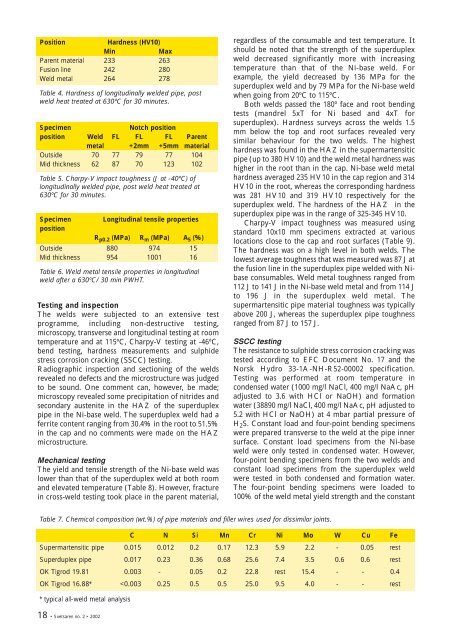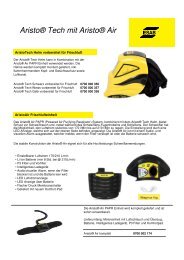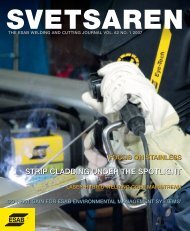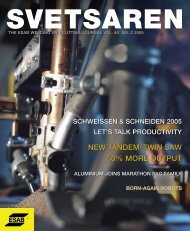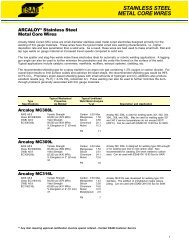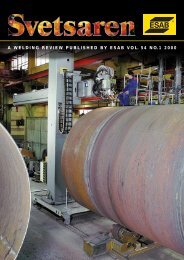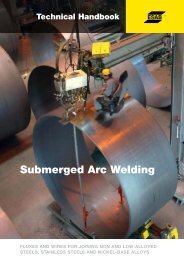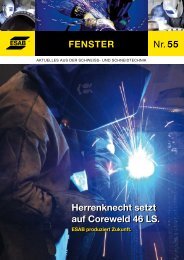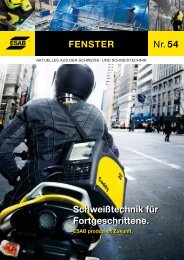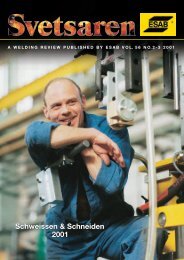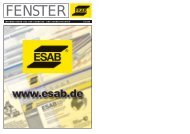Svetsaren_nr2 definitief (Page 1) - Esab
Svetsaren_nr2 definitief (Page 1) - Esab
Svetsaren_nr2 definitief (Page 1) - Esab
Create successful ePaper yourself
Turn your PDF publications into a flip-book with our unique Google optimized e-Paper software.
Position<br />
Hardness (HV10)<br />
Min<br />
Max<br />
Parent material 233 263<br />
Fusion line 242 280<br />
Weld metal 264 278<br />
Table 4. Hardness of longitudinally welded pipe, post<br />
weld heat treated at 630ºC for 30 minutes.<br />
Specimen<br />
Notch position<br />
position Weld FL FL FL Parent<br />
metal +2mm +5mm material<br />
Outside 70 77 79 77 104<br />
Mid thickness 62 87 70 123 102<br />
Table 5. Charpy-V impact toughness (J at -40ºC) of<br />
longitudinally welded pipe, post weld heat treated at<br />
630ºC for 30 minutes.<br />
Specimen Longitudinal tensile properties<br />
position<br />
R p0.2 (MPa) R m (MPa) A 5 (%)<br />
Outside 880 974 15<br />
Mid thickness 954 1001 16<br />
Table 6. Weld metal tensile properties in longitudinal<br />
weld after a 630ºC/ 30 min PWHT.<br />
Testing and inspection<br />
The welds were subjected to an extensive test<br />
programme, including non-destructive testing,<br />
microscopy, transverse and longitudinal testing at room<br />
temperature and at 115ºC, Charpy-V testing at -46ºC,<br />
bend testing, hardness measurements and sulphide<br />
stress corrosion cracking (SSCC) testing.<br />
Radiographic inspection and sectioning of the welds<br />
revealed no defects and the microstructure was judged<br />
to be sound. One comment can, however, be made;<br />
microscopy revealed some precipitation of nitrides and<br />
secondary austenite in the HAZ of the superduplex<br />
pipe in the Ni-base weld. The superduplex weld had a<br />
ferrite content ranging from 30.4% in the root to 51.5%<br />
in the cap and no comments were made on the HAZ<br />
microstructure.<br />
Mechanical testing<br />
The yield and tensile strength of the Ni-base weld was<br />
lower than that of the superduplex weld at both room<br />
and elevated temperature (Table 8). However, fracture<br />
in cross-weld testing took place in the parent material,<br />
regardless of the consumable and test temperature. It<br />
should be noted that the strength of the superduplex<br />
weld decreased significantly more with increasing<br />
temperature than that of the Ni-base weld. For<br />
example, the yield decreased by 136 MPa for the<br />
superduplex weld and by 79 MPa for the Ni-base weld<br />
when going from 20ºC to 115ºC.<br />
Both welds passed the 180º face and root bending<br />
tests (mandrel 5xT for Ni based and 4xT for<br />
superduplex). Hardness surveys across the welds 1.5<br />
mm below the top and root surfaces revealed very<br />
similar behaviour for the two welds. The highest<br />
hardness was found in the HAZ in the supermartensitic<br />
pipe (up to 380 HV10) and the weld metal hardness was<br />
higher in the root than in the cap. Ni-base weld metal<br />
hardness averaged 235 HV10 in the cap region and 314<br />
HV10 in the root, whereas the corresponding hardness<br />
was 281 HV10 and 319 HV10 respectively for the<br />
superduplex weld. The hardness of the HAZ in the<br />
superduplex pipe was in the range of 325-345 HV10.<br />
Charpy-V impact toughness was measured using<br />
standard 10x10 mm specimens extracted at various<br />
locations close to the cap and root surfaces (Table 9).<br />
The hardness was on a high level in both welds. The<br />
lowest average toughness that was measured was 87 J at<br />
the fusion line in the superduplex pipe welded with Nibase<br />
consumables. Weld metal toughness ranged from<br />
112 J to 141 J in the Ni-base weld metal and from 114 J<br />
to 196 J in the superduplex weld metal. The<br />
supermartensitic pipe material toughness was typically<br />
above 200 J, whereas the superduplex pipe toughness<br />
ranged from 87 J to 157 J.<br />
SSCC testing<br />
The resistance to sulphide stress corrosion cracking was<br />
tested according to EFC Document No. 17 and the<br />
Norsk Hydro 33-1A-NH-R52-00002 specification.<br />
Testing was performed at room temperature in<br />
condensed water (1000 mg/l NaCl, 400 mg/l NaAc, pH<br />
adjusted to 3.6 with HCl or NaOH) and formation<br />
water (38890 mg/l NaCl, 400 mg/l NaAc, pH adjusted to<br />
5.2 with HCl or NaOH) at 4 mbar partial pressure of<br />
H 2 S. Constant load and four-point bending specimens<br />
were prepared transverse to the weld at the pipe inner<br />
surface. Constant load specimens from the Ni-base<br />
weld were only tested in condensed water. However,<br />
four-point bending specimens from the two welds and<br />
constant load specimens from the superduplex weld<br />
were tested in both condensed and formation water.<br />
The four-point bending specimens were loaded to<br />
100% of the weld metal yield strength and the constant<br />
Table 7. Chemical composition (wt.%) of pipe materials and filler wires used for dissimilar joints.<br />
C N Si Mn Cr Ni Mo W Cu Fe<br />
Supermartensitic pipe 0.015 0.012 0.2 0.17 12.3 5.9 2.2 - 0.05 rest<br />
Superduplex pipe 0.017 0.23 0.36 0.68 25.6 7.4 3.5 0.6 0.6 rest<br />
OK Tigrod 19.81 0.003 - 0.05 0.2 22.8 rest 15.4 - - 0.4<br />
OK Tigrod 16.88*


